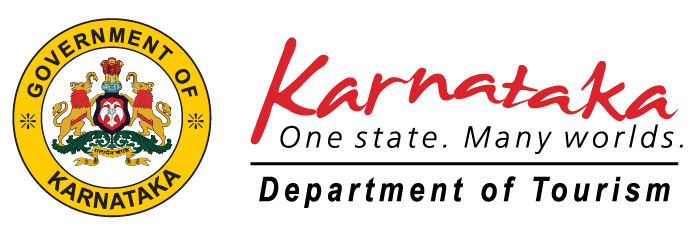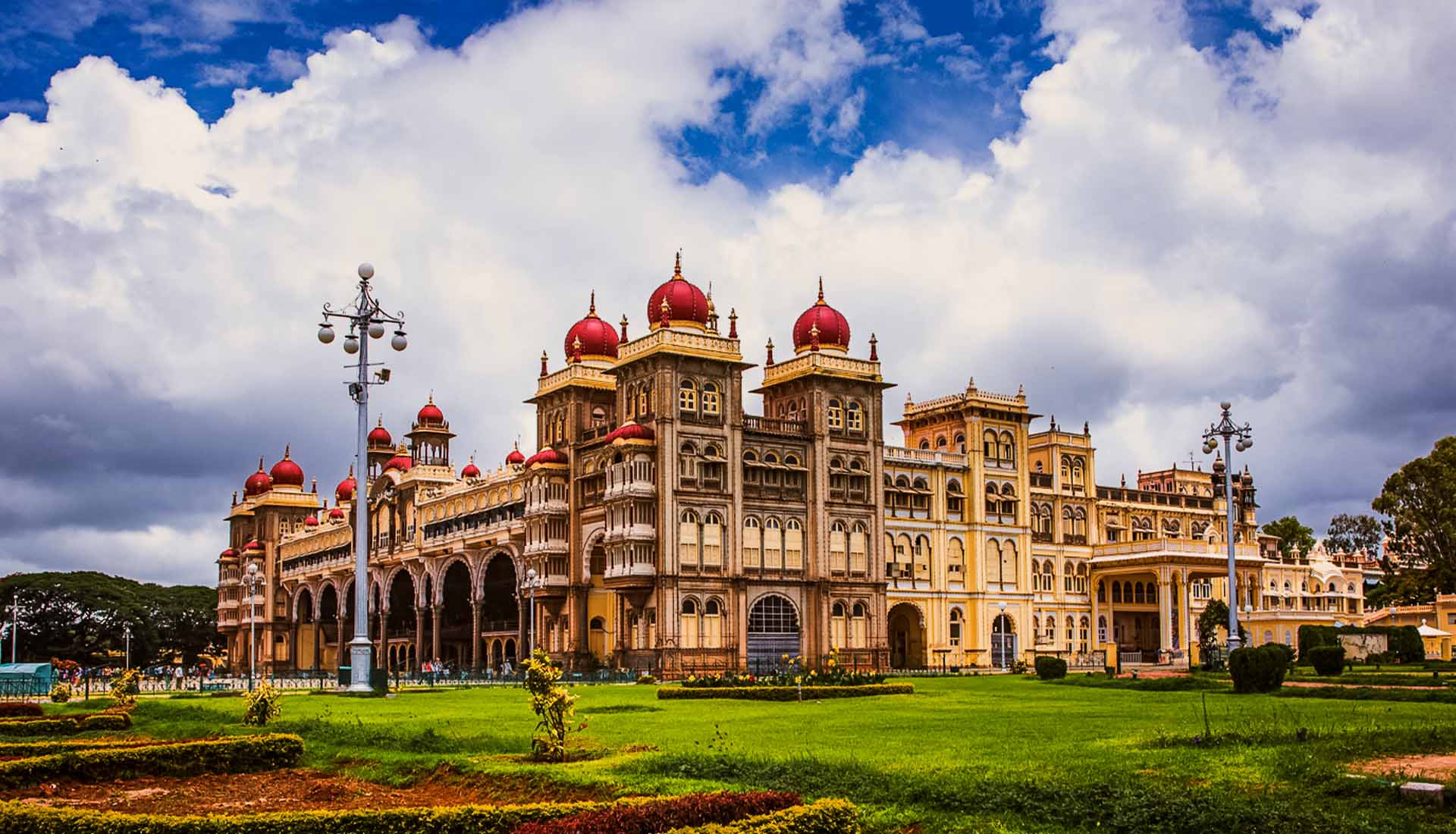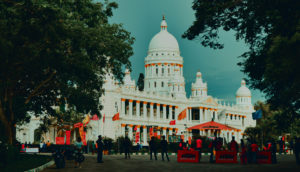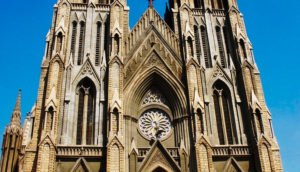Constructed in Indo-Saracenic style, the magnificent Mysuru Palace also known as Amba Vilas is the official residence of the Wadiyar dynasty and the seat of the Kingdom of Mysuru. Its exquisite interiors – replete with carved mahogany ceilings, stained glass, gilded pillars and glazed tiles – epitomizes royalty and grandeur. The palace, illuminated with 97,000 lights, turns into a glorious spectacle at dusk on Sundays and public holidays. It is arguably the most visited palace in India.
History: Mysuru Palace was built in the early 14th century by the royal family of Wodeyars. Mysuru palace was originally built in wood and was destroyed once by lightning (in 1638 AD), once by Tipu Sultan (in 1739 AD) and once again by fire in 1897 AD. Current Mysuru Palace is the fourth reconstruction, completed in 1912 and designed by British architect, Henry Irwin.
What to see in Mysuru Palace
- The Dolls’ Pavilion: The Gombe Thotti was originally meant to display dolls during the Dasara festivities. It is a tradition in Mysuru to worship dolls during Dasara, a tradition which was inherited from the Vijaynagar times. During these festivities, in every house, dolls were tastefully arranged. This tradition continues even today. During the time of Maharajas, this area was opened to the public (during Dasara festivities). Today, the bays of the western part of Gombe Thotti houses a collection of various objects of art including European marble sculptures acquired by the royalty.
- Golden Throne: In the northernmost bay of Gombe Thotti is the Golden Howdah also called the Ambari. It is the major attraction of the Mysuru Palace and it is the Royal Seat of the rulers of the Mysuru Kingdom. The core of this Howdah is a wooden structure in the form of a mantapa, which is covered with 80 Kgs of Gold Sheets having intricate designs consisting of scrolls, foliage and flowers. It is the focus of the Dasara Procession’s grand finale, a tradition that continues to this day also the idol of the presiding deity of the Mysuru city, Goddess Chamundeshwari, is taken in procession in the Golden Howdah.
- Public Durbar Hall: Most gorgeously decorated hall with a harmonious composition in colours where the king and his closest advisers would meet to discuss the affairs of state. The Golden Throne is placed in the octagonal pavilion on the western end of the hall and the descendant of the Mysuru Royal Family holds private ceremonials and sits on it during the Dasara Festivities.
- Paintings Gallery: Between 1934 and 1945, the Wadiyars commissioned five of the finest artists in Karnataka to paint the glory and grandeur of the Mysore Dasara Procession. 26 panels based on actual photographs were created and are displayed here.
- Marriage Pavilion: It’s an octagonal shaped hall where all royal weddings, birthdays and ceremonial functions were celebrated. Dome supported by clusters of pillars is of cast iron. There are 26 paintings, which depict Dasara procession. The stained-glass ceiling has a rich tapestry of peacock motifs and floral mandalas held in place by metal beams. The design of the glass and framework was created by the artists of Mysuru and manufactured in Glasgow.
- Portrait Gallery: Many valuable paintings and photographs of the Royal Family are exhibited in the portrait gallery on the southern part of the Kalyana Mantapa. The portrait gallery also exhibits two works of the famous royal artist Raja Ravi Varma dated in 1885.
- Wrestling Courtyard
The Kings of Mysuru were great patrons of wrestling and here wrestling competitions were conducted.
Mysuru Palace Temples
- Sri Lakshmiramana Swami Temple is one of the oldest temples in the city and is located towards the western part of the fort, inside the Palace.
- Sri Shweta Varahaswamy Temple is located beside the south gate. It’s constructed in the famous style of the great Hoysala Empire, which controlled most of Karnataka from the tenth until the fourteenth centuries.
- Sri Trinayaneshvara Swami Temple is an ancient temple and is located outside the original Mysuru fort, on the bank of Devaraya Sagar (Doddakere).
- Sri Prasanna Krishanswami temple is dedicated to Lord Krishna. The Mysuru dynasty claims its descent from Yadu Vamsa (Yadu Race) of Sri Krishna. Therefore, Krishnaraja Wadiyar III felt sad that there was no temple dedicated to Krishna. To fulfil this, he started the construction of Sri Prasanna Krishna Temple in 1825 and according to the inscription, it was completed in 1829.
- Kille Venkatramana Swamy Temple – During the time of Tipu, the Mysuru family was still in Srirangapatna. Queen Lakshmammanni, wife of Krishnaraja Wadiyar II was deeply worried about the dynasty and its future. Then lord Venkataramana is said to have appeared in her dream and directed her that his statue which is in Balamuri should be consecrated in Mysuru. By this pious act, her dynasty would get salvation. She, therefore, proceeded to Balamuri without the knowledge of the Sultan and brought the image of Venkataramana, consecrated it in the temple, and offered continuous worship. This is said to have helped the family and after the fall of Tippu, the Kingdom was restored to the Wadiyar dynasty.
- Sri Bhuvaneshwari Temple – located on the northern side of the Palace Fort corresponding to the Varahaswamy temple in the south, thus providing asymmetrical structure in the fort complex.
- Sri Gayatri Temple – located in the south-east corner of the fort directly corresponding to the Trinayaneshara Swamy temple constructed by Jayachamarajendra Wadiyar in 1953. Three shrines are here dedicated to Savithri, Gayathri and Saraswathi.
- Kodi Bharravasvami Temple is dedicated to Lord Shiva in the form of Bhairava.
Important information to visit Mysuru Palace:
- Timings/ Entrance Timings: Every day from 10.00 AM To 5.30 PM.
Tickets for (Indian / Foreign) Adults Rs 70 / head. Children above 10 years and below 18 years Rs 30 / head. - Illumination Timings: Sundays & Public Holidays from 7.00 PM – 8.00 PM
- Sound And Light Show (Son Et Lumiere) At The Palace – All Days Except Sundays & Govt. Holidays. 45 minutes sound and light show is performed at 7 PM & 8 PM on weekdays (Monday to Wednesday in Kannada & Thursday to Saturday in English)
How to reach Mysuru Palace:
By road: Bengaluru – 140 km. KSRTC and private operators have regular services to all important parts of the state and country.
By rail: Mysuru is well connected to Bengaluru, Chennai and other towns with numerous passenger and express trains. The city’s only 3 hours away from Bengaluru.
By air: Mysuru Airport – 10 km, Bengaluru – 140 km. KSRTC runs Flybus airport service to Mysuru from Bengaluru Airport
Places to stay in and around Mysuru: Mysuru city has hotels and resorts in all budget categories.
Official website: Click Here





